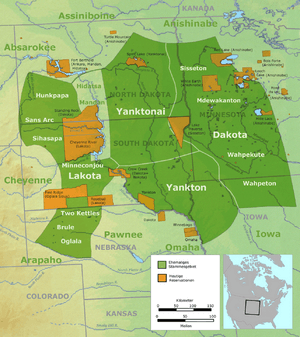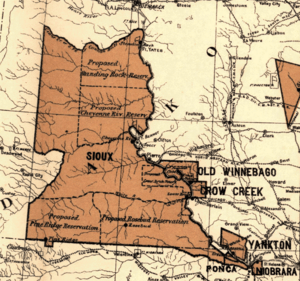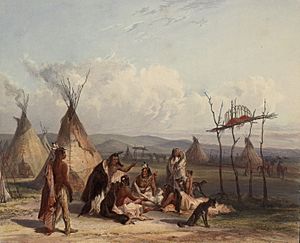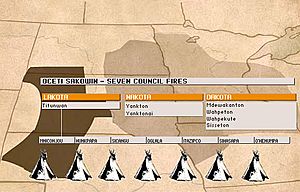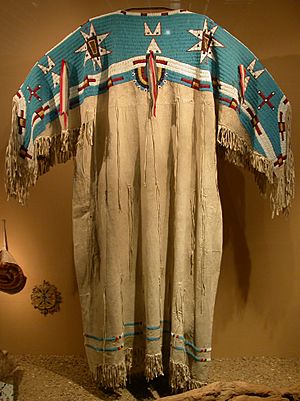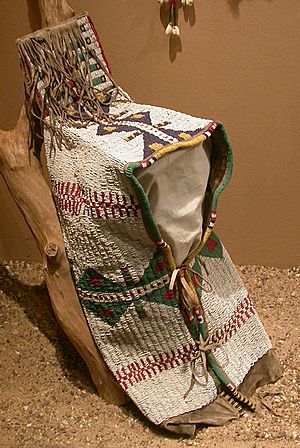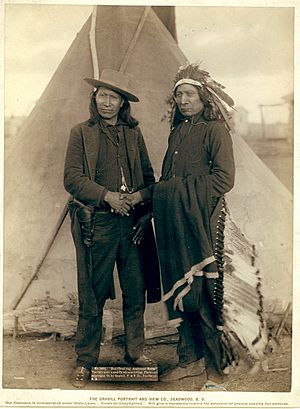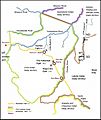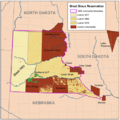Sioux facts for kids
| Očhéthi Šakówiŋ | |
|---|---|
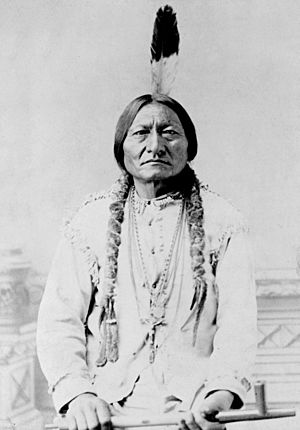
|
|
| Total population | |
| 170,110 | |
| Regions with significant populations | |
| US: (SD, MN, NE, MT, ND, IA, WI, IL, WY) Canada: (MB, SK) |
|
| Languages | |
| Sioux language (Lakota, Western Dakota, Eastern Dakota), Assiniboine, Stoney, English | |
| Religion | |
| Christianity (incl. syncretistic forms), traditional religion | |
| Related ethnic groups | |
| Assiniboine, Dakota, Lakota, Nakoda (Stoney), and other Siouan-speaking peoples |
The Sioux, also known as Očhéthi Šakówiŋ, are groups of Native American tribes and First Nations peoples in North America. These groups share similar languages and cultures. The word "Sioux" can refer to any group within the Great Sioux Nation or to their different language styles.
The Sioux are divided into three main groups based on their languages: the Dakota, Lakota, and Nakota.
The Santee Dakota (Isáŋyathi), meaning "Knife," live in the eastern parts of the Dakotas, Minnesota, and northern Iowa. The Yankton and Yanktonai Dakota (Iháŋktȟuŋwaŋ and Iháŋktȟuŋwaŋna), also called Wičhíyena, live near the Minnesota River. They are sometimes called the middle Sioux. The true Nakota are the Assiniboine and Stoney peoples in Western Canada and Montana. The Lakota, also known as Teton (Thítȟuŋwaŋ), are the westernmost Sioux. They were famous for their hunting and warrior ways.
Today, the Sioux have many separate tribal governments. They live on reservations, communities, and reserves in the United States (North Dakota, South Dakota, Nebraska, Minnesota, and Montana) and Canada (Manitoba, southern Saskatchewan, and Alberta).
Contents
What's in a Name?
The name "Sioux" came into English from French in the 1760s. It is a shorter version of Nadouessioux, first written down in 1640. Some say the name comes from an Ojibwe word meaning "little snakes." The -x ending is from French grammar.
The traditional name for the Great Sioux Nation is Očhéthi Šakówiŋ, which means "Seven Council Fires." Each "fire" stood for a group of people or a nation. The seven nations that make up the Sioux are: Mdewakanton, Wahpeton, Wahpekute, Sisseton, Yankton, Yanktonai, and Lakota (Teton).
These seven groups used to meet every summer. They would hold councils, renew family ties, decide tribal matters, and take part in the Sun Dance. The leaders of the seven groups would choose four main leaders. Being one of these four was a great honor. The last meeting of the Seven Council Fires was in 1850.
Today, the Teton, Santee, and Yankton/Yanktonai are usually known as Lakota, Eastern Dakota, or Western Dakota. In their languages, "Lakota" or "Dakota" means "friend" or "ally." This refers to the strong alliance that once united the Great Sioux Nation.
A Look at Sioux History
First Meetings with Europeans
The Dakota people were first recorded living near the source of the Mississippi River and the Great Lakes in the 1600s. They moved west in 1659 because of wars with the Iroquois. By 1700, the Dakota Sioux lived in Wisconsin and Minnesota. Around this time, a group called the Lakota moved to what is now South Dakota. In the late 1600s, the Dakota formed an alliance with French traders. The French wanted to gain an advantage in the North American fur trade against the English.
Sioux and French Traders
The first known meeting between the Sioux and the French happened in the winter of 1659–60. French traders like Radisson and Groseilliers reached what is now Wisconsin. Other French visitors included Claude-Jean Allouez and Daniel Greysolon Duluth. Trade with the French continued until France lost its lands in North America in 1763.
Sioux and Pawnee Conflicts
Historian Mark van de Logt described the conflicts between the Pawnees and the Sioux and Cheyennes as very intense. Both sides fought not just against warriors but against entire communities. The battle of Massacre Canyon on August 5, 1873, was the last major battle between the Pawnee and the Sioux.
The Dakota War of 1862
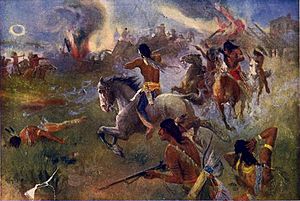
By 1862, the Dakota people were facing hard times. A crop failure the year before and a harsh winter led to starvation. Federal payments were late, and local traders refused to give them more credit. One trader, Andrew Myrick, famously said, "If they're hungry, let them eat grass."
On August 17, 1862, the Dakota War began. Some Santee men killed a white farmer and his family. This led to more attacks on white settlements along the Minnesota River. Settlers later found Myrick among the dead with his mouth full of grass.
After the conflict, 303 Santee Sioux were found guilty of murder. They were sentenced to be hanged. President Abraham Lincoln changed the sentences for 284 warriors. However, 38 Santee men were hanged on December 26, 1862, in Mankato, Minnesota. This was the largest mass execution in U.S. history on American soil.
Afterward, the U.S. government stopped treaty payments to the Dakota for four years. The money was given to white victims and their families. Many Santee fled to Canada or other parts of the Dakotas. Some joined Lakota groups further west to continue fighting the U.S. military. Others remained in Minnesota on small reservations. Today, their descendants live on reservations in the Dakotas, Nebraska, and Canada.
Red Cloud's War
Red Cloud's War (also called the Bozeman War) was a conflict between the Lakota and the United States Army from 1866 to 1868. It took place in the Wyoming Territory and Montana Territory. The war was fought over control of the Powder River Country.
The war is named after Red Cloud, an important Sioux chief. He led the fight against the United States because the U.S. military was moving into their lands. The war ended with the Treaty of Fort Laramie. The Sioux won this war, which helped them keep control of the Powder River country for a while.
Great Sioux War of 1876
The Great Sioux War of 1876 was a series of battles between the Lakota and their allies, like the Cheyenne, against the United States military. Key battles included the Battle of the Little Bighorn and the Battle of the Rosebud. This war, also known as the Black Hills War, mainly involved the Lakota tribes. It took place in Montana, Dakota, and Wyoming territories. The United States military eventually won this war.
Wounded Knee Massacre
The massacre at Wounded Knee Creek was the last major armed conflict between the Lakota and the United States. General Nelson A. Miles called it a "massacre."
On December 29, 1890, about 500 soldiers from the 7th Cavalry Regiment surrounded a camp of Lakota people. The soldiers had orders to move them to a railroad for transport. During the event, 25 soldiers and over 150 Lakota Sioux died, including men, women, and children. It's not known who fired the first shot. Some soldiers may have been hit by "friendly fire" because the shooting was very close and chaotic. About 150 Lakota are thought to have escaped, but many may have died from the cold.
Where Sioux People Live Today
In the late 1800s, railroads wanted to build tracks through Native American lands. To force the Plains Indians to move, railroad companies hired hunters to kill the bison herds. Bison were the main food source for the Plains Indians. The Dakota and Lakota were forced to accept U.S.-defined reservations. On these reservations, they were expected to farm and raise cattle instead of hunting. For many years, the Sioux depended on yearly payments from the government, as promised in treaties.
In Minnesota, treaties in 1851 left the Dakota with a reservation 20 miles wide on each side of the Minnesota River. Today, about half of all enrolled Sioux in the United States live outside reservations. To be an enrolled member of a Sioux tribe in the U.S., a person usually needs to have at least one-fourth Sioux ancestry (like one grandparent).
In Canada, the government calls tribal communities "First Nations." Their land holdings are called Indian reserves.
Sioux Religion
Sioux tribal religions, like many Native American faiths, were based on performance, oral stories, and changed within each community. Each generation used their traditions to create their own religious forms based on their experiences. These religions focused on the relationship between people and the sources of life, such as wind, sun, thunder, animals, and corn.
Sioux religious beliefs center around the Wakan Tanka, which means the Great Spirit. Two of their most important religious ceremonies are the Sun Dance and the Ghost Dance. The Sioux Nation was one of the few Native American peoples who practiced both these dances.
Sioux Languages
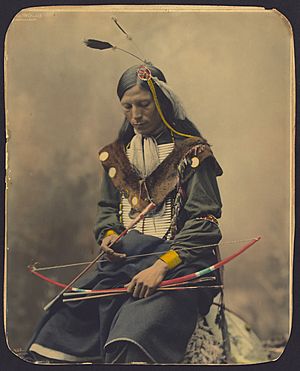
The Sioux people speak three closely related language groups:
- Eastern Dakota (also called Santee-Sisseton or Dakhóta)
- Santee (Isáŋyáthi: Bdewákhathuŋwaŋ, Waȟpékhute)
- Sisseton (Sisíthuŋwaŋ, Waȟpéthuŋwaŋ)
- Western Dakota (also called Yankton-Yanktonai or Dakȟóta)
- Yankton (Iháŋktȟuŋwaŋ)
- Yanktonai (Iháŋktȟuŋwaŋna)
- Lakota (also called Lakȟóta, Teton, Teton Sioux)
Older studies used to say that Lakota, Dakota, and Nakota were all dialects of one language. However, newer studies show that Yankton-Yanktonai speakers never called themselves Nakhóta. They pronounced their name like the Santee (Dakȟóta). These studies now say that Assiniboine and Stoney are two separate languages, and Sioux is a third language with three similar dialects: Lakota, Western Dakota (Yankton-Yanktonai), and Eastern Dakota (Santee-Sisseton).
Modern Sioux Communities
The Sioux have many separate tribal governments today. They live on reservations and in communities across North America. These include the Dakotas, Minnesota, Nebraska, and Montana in the United States. In Canada, they live in Manitoba, southern Saskatchewan, and Alberta.
The earliest European records show the Sioux living in Minnesota, Iowa, and Wisconsin. After they got horses in the early 1700s, the Sioux controlled much larger areas. Their lands stretched from central Canada to the Platte River, and from Minnesota to the Yellowstone River. This included the Powder River country.
Santee (Eastern Dakota)
The Santee moved north and west from the Southeastern United States, first into Ohio, then to Minnesota. Some came from the Santee River and Lake Marion area of South Carolina. The Santee River was named after them. In the past, they were a Woodland people who hunted, fished, and farmed.
In the 1600s and 1700s, Ojibwe people moved from the east. They had muskets from the French and British. This pushed the Dakota further into Minnesota and to the west and south. The U.S. later named the northern lands west of the Mississippi River "Dakota Territory."
Yankton-Yanktonai (Western Dakota)
The Iháŋkthuŋwaŋ-Iháŋktȟuŋwaŋna, also known as Yankton (Iháŋkthuŋwaŋ: "End village") and Yanktonai (Iháŋktȟuŋwaŋna: "Little end village"), are two of the seven council fires. The Yanktonai are divided into Upper Yanktonai and Lower Yanktonai (Hunkpatina).
These groups were involved in getting pipestone. The Yankton-Yanktonai moved into northern Minnesota. In the 1700s, they were recorded living in the Mankato region of Minnesota.
Lakota (Teton)
The Sioux likely got horses in the 1600s or early 1700s. The Teton (Lakota) group became very strong because of horses. They used their light cavalry to control the northern Great Plains, expanding their territory to the Rocky Mountains. The Lakota used to hunt bison and trade for corn with the eastern Sioux and other groups along the Missouri River. The name Teton or Thítȟuŋwaŋ is an old name; the people prefer to call themselves Lakȟóta.
Sioux Groups and Divisions
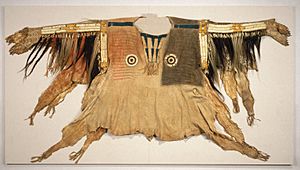
The Sioux are divided into three main groups. These larger groups are then divided into smaller sub-groups and even smaller bands.
- The Santee live on reservations and in communities in Minnesota, Nebraska, South Dakota, North Dakota, and Canada. After the Dakota War of 1862, many Santee were sent to the Crow Creek Indian Reservation and later to the Santee Sioux Reservation.
- Most Yanktons live on the Yankton Indian Reservation in southeastern South Dakota. Some Yankton live on the Lower Brule Indian Reservation and Crow Creek Indian Reservation. The Yanktonai are divided into Lower Yanktonai, who live on the Crow Creek Reservation, and Upper Yanktonai, who live in northern Standing Rock Indian Reservation, on the Spirit Lake Tribe in North Dakota, and in eastern Fort Peck Indian Reservation in Montana. They also live on several Canadian reserves.
- The Lakota are the westernmost of the three groups. They live in both North and South Dakota.
Today, many Sioux also live outside their reservations.
- Santee division (Eastern Dakota) (Isáŋyathi)
- Mdewakantonwan (Bdewékhaŋthuŋwaŋ "Spirit Lake Village")
- notable persons: Little Crow
- Sisseton (Sisíthuŋwaŋ, perhaps meaning "Fishing Grounds Village")
- Wahpekute (Waȟpékhute, "Leaf Archers")
- notable persons: Inkpaduta
- Wahpetonwan (Waȟpéthuŋwaŋ, "Leaf Village")
- Mdewakantonwan (Bdewékhaŋthuŋwaŋ "Spirit Lake Village")
- Yankton-Yanktonai division (Western Dakota) (Wičhíyena)
- Teton division (Lakota) (Thítȟuŋwaŋ, perhaps meaning "Dwellers on the Prairie"):
- Oglála (perhaps meaning "Those Who Scatter Their Own")
- notable persons: Crazy Horse, Red Cloud, Black Elk, Blue Horse, Iron Tail, Flying Hawk and Billy Mills (Olympian)
- Hunkpapa (Húŋkpapȟa, meaning "Those who Camp by the Door" or "Wanderers")
- notable persons: Sitting Bull
- Sihasapa (Sihásapa, "Blackfoot Sioux," not to be confused with the Algonquian-speaking Piegan Blackfeet)
- Miniconjou (Mnikȟówožu, "Those who Plant by Water")
- notable persons: Lone Horn, Touch the Clouds
- Brulé (French translation of Sičháŋǧu, "Burned Thigh")
- Sans Arc (French translation of Itázipčho, "Those Without Bows")
- Two Kettles (Oóhenupa, "Two Boilings")
- Oglála (perhaps meaning "Those Who Scatter Their Own")
Famous Sioux People
Historical Figures
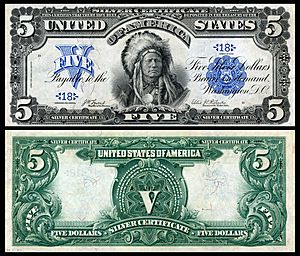
- Šóta (Old Chief Smoke) — an original Oglala Lakota head chief
- Siŋté Glešká (Spotted Tail) — Brulé chief who resisted joining Red Cloud's War
- Thaóyate Dúta (Little Crow/His Red Nation) — Mdewakanton Dakota chief and warrior
- Tȟatȟáŋka Íyotake (Sitting Bull) — Famous Hunkpapa Lakota chief and holy man
- Tȟašúŋke Witkó (Crazy Horse) — Famous Oglala Lakota warrior
- Maȟpíya Ičáȟtagye (Touch the Clouds) – Minneconjou Lakota chief and warrior
- Maȟpíya Lúta (Red Cloud) — Famous Oglala Lakota chief and spokesperson
- Heȟáka Sápa (Black Elk) — Famous Oglala Lakota medicine and holy man
- Ité Omáǧažu (Rain-in-the-Face) — Hunkpapa Lakota war chief
- Tȟáȟča Hušté (Lame Deer) — Mineconju Lakota holy man and spiritual preserver
- Wí Sápa (Black Moon) — Miniconjou Lakota chief
- Matȟó Héȟloǧeča (Hollow Horn Bear) — Sicangu (Brulé) Lakota leader
- Phizí (Gall) — Hunkpapa Lakota war chief
- Ógle Lúta (Red Shirt) — Oglala Lakota warrior and chief
- Inkpáduta (Scarlet Point/Red End) — Wahpekute Dakota war chief
- Waŋbdí Tháŋka (Big Eagle) — Mdewakanton Dakota chief
- Tamaha (One Eye/Standing Moose) — Mdewekanton Dakota chief
- Óta Kté (Luther Standing Bear/Plenty Kill) — Oglala Lakota writer and actor
- Núŋp Kaȟpá (Two Strike) — Sicangu Lakota chief
- Čhetáŋ Sápa (Black Hawk) — Itázipčho Lakota ledger artist
- Tȟatȟóka Íŋyaŋke (Running Antelope) — Hunkpapa Lakota chief
- Matȟó Watȟákpe (John Grass/Charging Bear) — Sihasapa Lakota chief
- Tȟatȟáŋka Ská (White Bull) — Miniconjou Lakota warrior and nephew of Sitting Bull
- Waŋblí Kté (Kill Eagle) — Sihasapa Lakota warrior and leader
- Šúŋkawakȟáŋ Tȟó (Blue Horse) — Oglala chief, warrior, educator and statesman
- Matȟó Wayúhi (Conquering Bear) — Sičháŋǧu Lakota chief
- Čhetáŋ Kiŋyáŋ (Flying Hawk) — Oglala Lakota chief, philosopher, and historian
- Matȟó Wanáȟtake (Kicking Bear) — Oglala born Miniconjou Lakota warrior and chief
- Uŋpȟáŋ Glešká (Spotted Elk/Big Foot) — Miniconjou Lakota chief
- Hé Waŋžíča (Lone Horn) — Miniconjou Lakota chief
- Kȟaŋǧí Yátapi (Crow King/Medicine Bag That Burns) — Hunkpapa Lakota war chief
- Wičháša Tȟáŋkala (Little Big Man/Charging Bear) — Oglala Lakota Warrior
- Šúŋka Khúčiyela (Low Dog) — Oglala Lakota chief and warrior
- Wašíčuŋ Tȟašúŋke (American Horse) ("The Younger") — Oglala Lakota Chief
- Wašíčuŋ Tȟašúŋke (American Horse) ("The Elder") — Oglala Lakota Chief
- Tȟašúŋke Kȟokípȟapi (Young Man Afraid Of His Horses) — Oglala Lakota Chief
- Ištáȟba (Sleepy Eye) — Sisseton Dakota chief
- Ohíyes’a (Charles Eastman) — Author, physician and reformer
- Colonel Gregory "Pappy" Boyington — World War II Fighter Ace and Medal of Honor recipient; 1/4 Sioux
- Charging Thunder (1877–1929), Blackfoot Sioux chief who was part of Buffalo Bill's Wild West Show in 1903. He stayed in England and became George Edward Williams. He worked at the Belle Vue Zoo as an elephant keeper.
- Óta Kté (Luther Standing Bear) — Author, educator, philosopher and actor
- Ziŋtkála-Šá (Gertrude Simmons Bonnin) — Author, educator, musician and political activist
Images for kids
-
Chief Black Tail Deer and his family at the 1904 World's Fair
-
Ledger artwork by Lakota artist Black Hawk showing a Heyókȟa, a dreamer of a Wakíŋyaŋ (thunder being), around 1880
-
Chief Red Cloud and other Lakota leaders, around 1865-1880
-
Yankton Pipestone Quarries as seen by George Catlin in 1836
-
Drawing of the mass hanging of Dakota in Mankato, Minnesota
-
Map showing the major battles of Red Cloud's War, along with major treaty boundaries. During Red Cloud's War, the Sioux defeated the US Army on the same plains where they previously defeated the Crow
-
Solen Basketball team, Standing Rock Agency (1947)
-
Family members of U.S. Army Master Sgt. Woodrow Wilson Keeble attending his Medal of Honor ceremony
-
Woodrow Keeble, Medal of Honor recipient.
See also
 In Spanish: Siux para niños
In Spanish: Siux para niños


